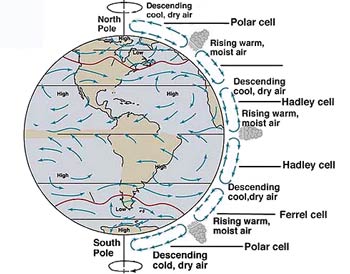At the most basic level, winds on the surface of the Earth are caused by uneven heating of the surface from the sun. As the sun heats the surface of the Earth, air is heated and rises. Because the Equator receives the most solar heating, air rises in the equatorial region, creating a low-pressure region. Air from the equatorial region flows poleward high in the atmosphere because there is a pressure gradient with the high pressure region at the Equator. The wind at the surface moves toward the equator due to the pressure gradient at the surface. The Coriolis force deflects the winds moving toward the Equator, to the right in the Northern Hemisphere, resulting in the Northeast Trade Winds and to the left in the Southern Hemisphere resulting in the Southeast Trade Winds.
Between the high pressure region around 30°and the low pressure region around 60°, surface flow is toward the poles. That flow is deflected by Coriolis (right in the Northern Hemisphere and left in the Southern Hemisphere) to become the Westerlies in the mid-latitudes. Finally, cold air flowing equatorward from the poles is deflected by Coriolis to become the Polar Easterlies. This is an idealized circulation and the reality is much more complicated (including additional factors such as friction at the surface). |


